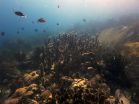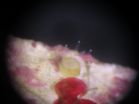The study provides the first photos and documentation of juveniles of this species, and could provide information to help bolster local coral reef conservation. The team also plans to 'out-plant' these lab-grown juveniles in the wild which could help populations become more resilient to climate change.
The findings will be presented in a talk at the annual TED Conference in Vancouver on Monday 16th March at approximately 4:00 PM Pacific Time.
The Caribbean Pillar Coral Dendrogyra cylindrus is rare and understudied, and small juveniles of this species have never been seen in over 30 years of surveys in the Caribbean. The species is one of very few corals in the Caribbean that forms large branches, which can provide shelter for important fish species and reduce the energy of storm surge as it approaches shore.
Lead author and TED Senior Fellow Kristen Marhaver from the CARMABI Foundation on the Caribbean island of Curaçao said: "Strangely enough, pillar corals happen to spawn just half an hour before another threatened coral that is far better studied - the elkhorn corals. So the reason why for so many years we've never witnessed spawning pillar corals is that, while they were spawning, virtually all coral spawning researchers and photographers in the Caribbean were on their boats doing final preparations on their dive gear for elkhorn coral spawning. It was literally right under our noses for years."
Pillar Corals form a unique 'smoke stack' shape like no other coral species, and they display unusual mating behaviour compared to most spawning coral species. Most spawning corals are hermaphrodites that release large bundles of eggs and sperm. Pillar corals, which only spawn on a few specific nights of the year, build colonies that are either all-male or all-female. The males first release sperm into the seawater, shortly followed by the females releasing their individual eggs. This makes collection and breeding research extremely difficult.
Kristen Marhaver, who began this work while she was a postdoctoral researcher at the University of California at Merced, USA, said: "Now that we've successfully reared juvenile Pillar Corals in the lab, not only can we study them in more detail to find out what factors could be threatening their survival in the wild, but it also means that we can try to out-plant a small number back to the reef. We don't know if this will work and it is certainly not a cure-all for the reef. But especially in such a rare coral species, a tiny boost of a few new individuals could make a big difference in their genetic diversity, allowing their populations to adapt and become more resilient to the changing environment in the oceans."
After studying the sunset times and lunar cycles taken from other spawning observations, the research team timed their egg and sperm collection around the most likely annual spawning times - exactly three nights after the August full moon and around 100 minutes after sunset. At depths of 6-7 meters on a Curaçaoan coral reef with a large population of Pillar Corals, the team arranged nets and funnels over the female colonies to automatically collect eggs, and used syringes near the male colonies to manually collect sperm from spawn clouds as they appeared.
The team then attempted to fertilize the eggs by mixing the collected eggs and sperm underwater and on shore. In the lab, the team carefully adjusted several factors related to fertilization times and seawater type and nurtured the eggs to develop into larvae. They managed to successfully grow the embryos to the swimming larvae stage - the first time this have ever been seen - and settled them onto ceramic tripods in water tanks. The settled juveniles then survived for over seven months.
Now that they have determined how best to grow these coral in the lab, work can begin on studying how different factors affect their survival. By testing in the lab the effect of water type, contaminants, or the presence of different species of animals and bacteria, they may be able to translate these findings to the wild, and explain why juvenile pillar corals are missing in certain areas, helping to support local coastal protection.
Populations of branching coral colonies are often genetically identical, making them extremely susceptible to threats such as disease and temperature shock. The team therefore plans to return a few lab-reared juveniles to the reef to see if they will grow and help jumpstart the population's genetic diversity. This could help the species adapt and become more resilient to threats such as climate change.
There is also growing evidence that juvenile corals can in some places better adjust to changing environments than adult corals. The introduction of new juveniles to the reef could therefore help buffer these ecosystems against global threats that affect all corals.
Kristen Marhaver said: "Given how rare the juveniles are in nature, it was a bit of a question whether the species was still reproducing at all. Corals can also reproduce by fragmentation, so a huge field of pillar corals could in fact be from one single parent colony and might not be able to reproduce. Now that we have some of the first solid evidence that they are still able to reproduce, it means we can be cautiously optimistic about the future of this threatened species."
INFORMATION:
The research team included Mark Vermeij from the CARMABI Foundation and the University of Amsterdam, and Mónica Medina from Pennsylvania State University. The research was funded by the US National Science Foundation with permissions from the Government of Curaçao.
Notes to editor:
1. Photos of the coral during dives and in the lab can be found at: http://bit.ly/1Em7l2S. Please credit images as provided in the file names.
Videos of the coral during dives are available on BioMed Central's YouTube channel and can be linked to: http://www.youtube.com/playlist?list=PLtZNoPFqweyZUM3V10VxPjxGklVvWpxDt
Copies of the HD video files are also available for re-use. Please contact joel.winston@biomedcentral.com for copies.
2. TED Conference talk sessions begin at 12:45pm Pacific Time on Monday 16th March and Kristen Marhaver is scheduled to speak at 4:00pm Pacific Time.
3. Research article
Kristen L Marhaver, Mark JA Vermeij and Monica M Medina
Reproductive natural history and successful juvenile propagation of the threatened Caribbean Pillar Coral Dendrogyra cylindrus
BMC Ecology 2015
DOI: 10.1186/s12898-015-0039-7
After embargo, article available at journal website here: http://dx.doi.org/10.1186/s12898-015-0039-7
4. BMC Ecology is an open access, peer-reviewed journal that considers articles on environmental, behavioral and population ecology as well as biodiversity of plants, animals and microbes.
BMC Ecology is part of the BMC series which publishes subject-specific journals focused on the needs of individual research communities across all areas of biology and medicine. We offer an efficient, fair and friendly peer review service, and are committed to publishing all sound science, provided that there is some advance in knowledge presented by the work.
5. BioMed Central is an STM (Science, Technology and Medicine) publisher which has pioneered the open access publishing model. All peer-reviewed research articles published by BioMed Central are made immediately and freely accessible online, and are licensed to allow redistribution and reuse. BioMed Central is part of Springer Science+Business Media, a leading global publisher in the STM sector. http://www.biomedcentral.com


